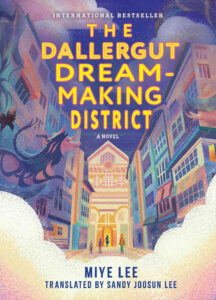 The Dallergut Dream-Making District by Miye Lee
The Dallergut Dream-Making District by Miye Lee Series: The Dallergut Dream Department Store #2
Genres: Cozy Fantasy, Adult, Asian Literature, Korean Literature, Fantasy, Low Fantasy, Magical Realism
Published by Hanover Square Press on June 24, 2025
Format: eBook
Pages: 302

In this bestselling follow-up to The Dallergut Dream Department Store, beloved characters must visit a special dream-making district to unlock new secrets about the customers they lost and hope to bring back.
It's been a year since Penny first walked through the doors of the Dallergut Dream Department Store, and surviving a year at the store means one thing… She is now an official employee of the dream industry! She can finally take the express commuter train to the Company District, where all the dream-production companies are located, and discover how all raw dream materials and testing equipment are produced.
But the Company District is not quite what she expected. Instead it hides a secret underbelly of the magical industry that Penny thought she was a part of.
Penny discovers the Civil Complaint Center, full of people filing complaints about their dreams. She also learns about the regular customers who have stopped coming to the store. As she gets to the bottom of each complaint, she begins to expand her horizons, moving beyond the role of dreamseller to understanding what lies in the hearts of their lost regulars.
The Dallergut Dream-Making District delves deeper into the dream industry and its customers. Why do some of them buy a dream and never return? And can Penny and her colleagues bring their regulars back?
The second novel in Lee Miye’s Dallergut Dream Department Store duology, The Dallergut Dream-Making District continues Lee’s whimsical take on the dream world and its inhabitants. Picking up not long after Penny’s employment at the famed dream-selling department store, this novel expands on its dreaming mechanics in expectedly creative and refreshing ways. While still comprised of several short stories and vignettes covering different aspects of dream-creation and experiences, like a real department store, this novel explores what happens when a customer has a complaint about their purchased dream or those that have issues with dreaming in general. Continuing with the first novel’s unique ideas paired with its signature cozy and casual presentation, this book is exactly the sequel one would expect and enjoy, referencing its past short stories and neatly tying up the few loose plotlines previously left as unresolved breadcrumbs.
Similar to the first novel in the duology, the Dallergut Dream-Making District follows first floor store employee Penny’s exploration of the dream-making and selling industry presented through several short stories. However, unlike the first novel that followed a preset formula of each story introducing a new type of dream and a representative creator, this book instead looks at other areas outside of the dreams themselves. Some of the content covered in these short stories include the Complaint Center for dreamers unhappy with their dreams, mysteries of why certain long-time customers are no longer visiting the store, artistic quality vs mass-consumer appeal, the in-lore legend of the Time God and the Three Disciples, and more. Of particular interest however are the stories that involve people who cannot dream, whether it be due to physical/mental limitations outside of their control or those that purposely choose not to dream. While the first novel had an inquisitive feeling that matched Penny’s naivety and inexperience with dreams, this second novel has a more sophisticated, yet wistful undercurrent beneath the cozy and pastel-colored sights. Regardless of the content of each story, there’s a recurring theme of “memories” and reflections on what they mean to people. As one would expect based on that kind of motif, the tone is a bit more nuanced compared to the Dallergut Dream Department Store and likewise, Lee’s writing also feels more mature, introspective, and assured.
While still predominantly a stand-in for the reader experiencing the dream world, Penny is slightly more present in this second novel which also has a more structured story. Each of the short stories introduce a mechanic of the dream world or important details past stories eluded to, culminating in a grand festival hosted by the Dallergut store. Of those stories, my favorite was easily the fourth story that explores the concept of lucid dreaming and cognitive recognition while asleep. Not only are Lee’s artistic applications of lucid dreaming creative, but this story also serves as the follow-up and resolution to one of the first book’s epilogue chapters, the most character-focused and compelling narrative material featured for me. This story seamlessly weaves Lee’s increasingly complex dream world with character work that’s generally limited in this duology, adding much needed substance and weight to the read. The fact that it also focuses on one of the series’ most interesting dream-sellers Vigo Myers, an aspiring dream-maker who was mysteriously banned right before his graduation, certainly helps. It’s just a bit unfortunate that this story is slotted mid-way into the Dallergut Dream-Making District where it feels like the story narratively peaks too early. The stories that follow are still great, but they aren’t quite as sentimental or they feature new one-off characters that the reader isn’t as invested in. That said, I found it wonderful to see Penny growing as both a character and as a competent Dallergut employee who’s able to provide more input to the story rather than merely being an observer.
While on paper it largely delivers a very similar reading experience to the first book, the Dallergut Dream-Making District is a natural successor that smartly builds on the previous stories without becoming repetitive or bland. While retaining its signature cozy and casual presentation, this novel’s content feels even more creative than the first book, complimented by Lee and translator Sandy Joosun Lee’s (unrelated to Miye Lee) more sophisticated and polished writing. I openly admit the whimsical and cozy Asian literature trend of pairing ordinary locations with colorful fantasy-inspired concepts is not for me personally, but Lee’s Dallergut Dream Department Store is easily my favorite thus far as it avoids the common pitfalls of being comically overdramatic (possibly lost in translation) or unsatisfying vague. Only recently translated and released in English by Hannover Square Press, this novel was originally published in Korea four years ago and there haven’t been any signs of another sequel in the works, however I would love to be able to return to this series again as there’s certainly other interesting areas and topics left to explore that I’m sure Lee would be able to incorporate wonderfully into her imaginative dream-making world.
